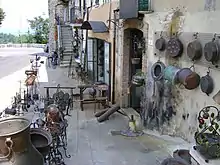Guardiagrele
Guardiagrele (Italian pronunciation: [ɡuardiaˈɡreːle]; Abruzzese: La 'Uàrdije; Latin: Guardia Graelis) is a town and comune in the province of Chieti, part of the Abruzzo region of central Italy. It is in the foothills of the Maiella mountain at an elevation of around 576 metres (1,890 ft). Its population numbers about 10,000.
Guardiagrele | |
|---|---|
| Comune di Guardiagrele | |
 | |
 Coat of arms | |
Location of Guardiagrele | |
 Guardiagrele Location of Guardiagrele in Italy  Guardiagrele Guardiagrele (Abruzzo) | |
| Coordinates: 42°12′N 14°13′E | |
| Country | Italy |
| Region | Abruzzo |
| Province | Chieti (CH) |
| Frazioni | Anello, Bocca di Valle, Caporosso, Caprafico, Caprafico piane, Cerchiara, Colle Barone, Colle Luna, Comino, Crognaleto, Melone, Piano Fonti, Piana San Bartolomeo, San Biase, San Domenico, San Leonardo, Santa Lucia, San Vincenzo, Sciorilli, Tiballo, Villa San Vincenzo, Voire |
| Government | |
| • Mayor | Donatello Di Prinzio |
| Area | |
| • Total | 56 km2 (22 sq mi) |
| Elevation | 576 m (1,890 ft) |
| Population (31 December 2010)[2] | |
| • Total | 9,497 |
| • Density | 170/km2 (440/sq mi) |
| Demonym | Guardiesi |
| Time zone | UTC+1 (CET) |
| • Summer (DST) | UTC+2 (CEST) |
| Postal code | 66016 |
| Dialing code | 0871 |
| Patron saint | Donatus of Arezzo |
| Saint day | August 7 |
| Website | Official website |
Commenting on the views of the mountains and valleys of the Maiella visible from some points in the town, the poet Gabriele d'Annunzio nicknamed Guardiagrele la terrazza d'Abruzzo ("Abruzzo's terrace").
Guardiagrele is the seat of the Maiella National Park, and is a member of the I Borghi più belli d'Italia ("The most beautiful villages of Italy") association.[3]
Main sights


The biggest church in Guardiagrele is Santa Maria Maggiore of which it has been written:[4]
The façade presents a splendid 14th-century gothic portal, among the most elegant in the Abruzzi Gothic style. The Coronation of the Virgin sculpture group in the portal lunette is also magnificent, attributed to the school of Nicola di Guardiagrele. Under the colonnaded portico, next to the lateral door, is the splendid fresco by Andrea De Litio (1473) portraying Saint Christopher. In the interior, completely rebuilt in the 18th century following an earthquake, crumbling stucco-work in the Baroque style and a shrine of the same period set off a 15th-century fresco representing the Madonna of the Milk.
In addition to Santa Maria Maggiore, there are several other churches and palazzi or mansions of various ages which are of architectural interest, including S. Nicola di Bari (founded in the 4th century), the convent of the Chapuchins (1599), Palazzo De Lucia (16th century), Palazzo Elisii (15th-18th century), the cloister of the Palazzo Comunale Piazza San Francesco (17th century) and Palazzo Marini (1391).
Museums include:
- Museo Civico (Civic Museum)
- Museo del Costume e della Tradizione della Nostra Gente (Costume and Folk Museum)
- Museo del Duomo ("Cathedral Museum"), in Santa Maria Maggiore
- Museo Archeologico ("Archaeological Museum").
Culture

Known throughout Abruzzo for its wrought-iron craft, copper craft and gold-work, Guardiagrele was the home of the great goldsmith and sculptor Nicola da Guardiagrele, who was born there in the late 14th century.
The patron saints of Guardiagrele are Saint Donatus of Arezzo and Saint Emidius. Annually between the 6th and 8 August there is a festival celebrating these saints in which the effigy of Donatus is paraded around the streets of Guardiagrele. It is traditional to eat porchetta (oven or spit roasted suckling pig flavoured with pepper, rosemary, garlic and other seasonings) at this time.
In the 11th century Archimandrite Saint Nicholas the Greek led a group of monks fleeing the Saracens who had occupied Calabria. In 1338 his body was moved to Guardiagrele and interred in la Chiesa di San Francesco (14th century). His saint's day is celebrated on the third Sunday of May.
The church preserved in its choirbooks the important Guardiagrele Codex, of polyphonic works by Landini and anonymous composers.
References
- "Superficie di Comuni Province e Regioni italiane al 9 ottobre 2011". Italian National Institute of Statistics. Retrieved 16 March 2019.
- "Popolazione Residente al 1° Gennaio 2018". Italian National Institute of Statistics. Retrieved 16 March 2019.
- "Abruzzo" (in Italian). Retrieved 1 August 2023.
- I Borghi più belli d'Italia
External links
- I Borghi più belli d'Italia - Entry on Guardiagrele (in English)
- Examples of the poetry of the dialect poet Modesto della Porta